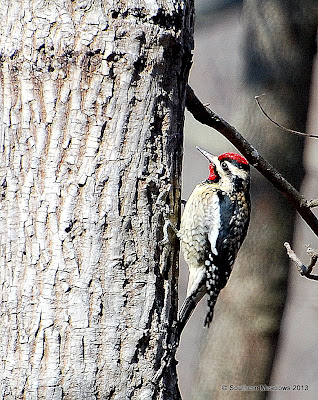Yellow-bellied Sapsucker
As I walk around in our woodland garden I often hear a slow, irregular beat as if someone is sending a message via Morse code. This is the sound of the yellow-bellied sapsucker. I am seeing a lot of them in our garden now. They are highly migratory birds and overwinter in the Southern part of the U.S. where sap is more readily available to them at this time of year.
Sapsuckers drill holes in uniform rows or columns (or both) in over 200 species of native trees but they seem to prefer oaks, ashes, and maples. They often select trees that are wounded or weakened from insects, disease, lightning, or wind. It is thought that the sap from trees in poor health contain higher levels of protein and amino acids. From where I sit this is a win-win collaboration for the birds and our gardens.
These woodpeckers feed on the sap by licking it up with their tongue which resembles a paintbrush. Since trees usually seal over wounds to prevent sap from being lost you may wonder how the sapsuckers keep the sap flowing so abundantly. According to the Smithsonian, researchers believe that the sapsucker saliva may contain a substance that acts as an anticoagulant that prevents sap from clogging up and sealing the holes.
Sapsuckers are one of the few animals that are capable of getting the phloem sap from trees (as opposed to the xylem sap which humans harvest for syrup). Phloem sap is more nutritious and therefore many other animals like to feed from the sap wells the sapsuckers make available. Hummingbirds, warblers, nuthatches, cedar waxwings, other woodpeckers, bats, and squirrels will eat the sap and the insects that are attracted to these holes.
The rufous hummingbirds (see post here) that are overwintering in my garden are almost certainly feeding from these wells. The sap is very similar to flower nectar in the amount of nutrients and sugar it offers and makes a great substitute when flowers are not blooming. I read that the yellow-bellied sapsucker has been known to feed at hummingbird feeders too. That I would like to see!
I have watched them at the suet feeders on cold mornings but usually they are busy in the trees and blend in pretty well until the light shows off their red cap.
They will leave my area in spring (mid-April/May) to head North where they will nest/breed during the summer months.
The Great Backyard Bird Count is February 15th -18th. Mark your calendars so you can participate. Also, if you want to learn more there is a FREE webinar (here) on January 29th from 2:00-3:00 EST.
Sapsuckers drill holes in uniform rows or columns (or both) in over 200 species of native trees but they seem to prefer oaks, ashes, and maples. They often select trees that are wounded or weakened from insects, disease, lightning, or wind. It is thought that the sap from trees in poor health contain higher levels of protein and amino acids. From where I sit this is a win-win collaboration for the birds and our gardens.
These woodpeckers feed on the sap by licking it up with their tongue which resembles a paintbrush. Since trees usually seal over wounds to prevent sap from being lost you may wonder how the sapsuckers keep the sap flowing so abundantly. According to the Smithsonian, researchers believe that the sapsucker saliva may contain a substance that acts as an anticoagulant that prevents sap from clogging up and sealing the holes.
Sapsuckers are one of the few animals that are capable of getting the phloem sap from trees (as opposed to the xylem sap which humans harvest for syrup). Phloem sap is more nutritious and therefore many other animals like to feed from the sap wells the sapsuckers make available. Hummingbirds, warblers, nuthatches, cedar waxwings, other woodpeckers, bats, and squirrels will eat the sap and the insects that are attracted to these holes.
 |
| Rufous Hummingbird |
The rufous hummingbirds (see post here) that are overwintering in my garden are almost certainly feeding from these wells. The sap is very similar to flower nectar in the amount of nutrients and sugar it offers and makes a great substitute when flowers are not blooming. I read that the yellow-bellied sapsucker has been known to feed at hummingbird feeders too. That I would like to see!
I have watched them at the suet feeders on cold mornings but usually they are busy in the trees and blend in pretty well until the light shows off their red cap.
They will leave my area in spring (mid-April/May) to head North where they will nest/breed during the summer months.
The Great Backyard Bird Count is February 15th -18th. Mark your calendars so you can participate. Also, if you want to learn more there is a FREE webinar (here) on January 29th from 2:00-3:00 EST.




.png)
